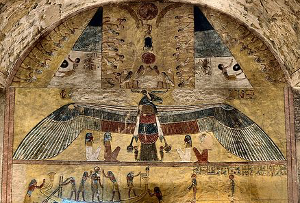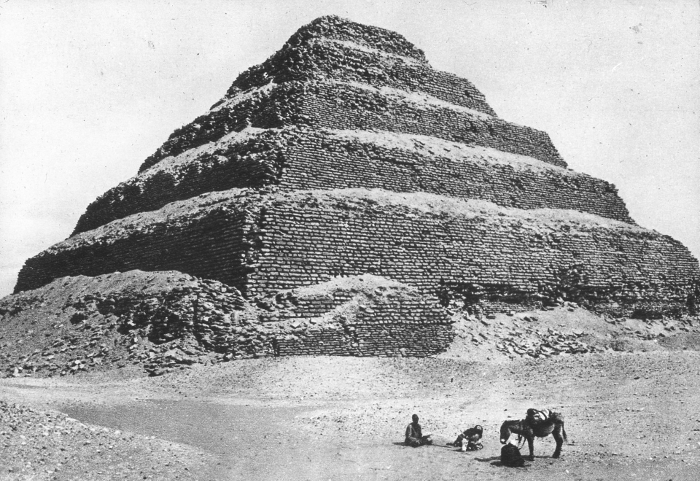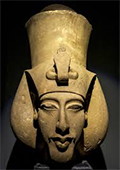|
|

A History of Ancient Egypt
|

|
|
Share This Page
|
|
|
|
|
|
|
Follow This Site

|
 |
|
|
|
|

|
Part 2: Lords of the Two Lands
 An Egyptian priest named Manetho, who lived in the 3rd Century B.C., was the first to publish a chronological list of the rulers of Ancient Egypt. In the Aegyptiaca, or "History of Egypt," Manetho divided the pharaohs into a number of dynasties. A change of dynasty could be a ruler who was not from the same bloodline as his predecessor; a change of dynasty could also come based on a geographical reason, such as when the royal capital changed locations.
An Egyptian priest named Manetho, who lived in the 3rd Century B.C., was the first to publish a chronological list of the rulers of Ancient Egypt. In the Aegyptiaca, or "History of Egypt," Manetho divided the pharaohs into a number of dynasties. A change of dynasty could be a ruler who was not from the same bloodline as his predecessor; a change of dynasty could also come based on a geographical reason, such as when the royal capital changed locations.
The Aegyptiaca had three volumes:
- Volume 1 started with a discussion of the gods and the beginnings of humanity and then Dynasties I–XI
- Volume 2 charted Dynasties XII–XIX, including the Hyksos interregnum
- Volume 3 chronicled Dynasties XX–XXX.
Stories of the earliest settlements speak of a leader known as Scorpion, who may have take charge in Upper Egypt and tried to take over Lower Egypt as well. Narmer (also referred to as Menes) is thought to have been the first to unite Lower Egypt and Upper Egypt and to have established Memphis as his capital. He was the first king of the first dynasty, starting in 3150 B.C. The 30th Dynasty ended with Nectabeno II, the last native ruler of Ancient Egypt, whose rule ended in 342 B.C. Egypt then came under a series of foreign rulers, including the Persian Empire, Alexander the Great, and Rome.
Manetho also divided the dynasties into various periods:
- The Early Dynastic Period (3150 B.C.–2686 B.C.) consisted of the First Dynasty and the Second Dynasty
- The Old Kingdom (2686 B.C.–2613 B.C.)spanned the Third to the Sixth Dynasty.
- Next came the First Intermediate Period (2181 B.C.–2060 B.C.), a period of political certainty in the wake of the collapse of the Old Kingdom, perhaps because of a widespread drought that plagued other nearby civilizations. This period spanned the Seventh to the Eleventh Dynasties.
 The Middle Kingdom (2060 B.C.–1802 B.C.) technically includes the last part of the Eleventh Dynasty, starting with King Mentuhotep II, generally regarded as a ruler who reunited all of Egypt after a period of divided rule. The end of the Twelfth Dynasty was the end of the Middle Kingom.
The Middle Kingdom (2060 B.C.–1802 B.C.) technically includes the last part of the Eleventh Dynasty, starting with King Mentuhotep II, generally regarded as a ruler who reunited all of Egypt after a period of divided rule. The end of the Twelfth Dynasty was the end of the Middle Kingom.- The Second Intermediate Period (1802 B.C.–1550 B.C.) included the Thirteenth through the Seventh Dynasties. It was during this time that the Hyksos (Fifteenth Dynasty) reigned over Lower Egypt.
- The New Kingdom (1550 B.C.–1077 B.C.) included the Eighteenth through the Twentieth Dynasties and featured some of Egypt's most famous rulers, many of whom are buried in the Valley of the Kings.
- Also known as the Libyan Period, the Third Intermediate Period (1077 B.C.–664 B.C.) included the Twenty-first through the Twenty-fifth Dynasties.
- The Late Period included the last of the dynasites, ending with the annexation of Egypt by Alexander the Great.
Historians know of a large handful of earlier list of Egypt's kings, among them the Palermo stone (Fifth Dynasty), the Giza King List (Sixth Dynasty), the Karnak King List (Eighteenth Dynasty), the Turin King List (Nineteenth Dynasty), and a few from both Abydos and Saqqara.
Some of the most famous king of Ancient Egypt were these:
- Djoser, the first ruler of the Third Dynasty who is most well-known for building the Step Pyramid.
- Khufu, a Fourth Dynasty king who build the Great Pyramid at Giza
- Ahmose I, who drove out the Hyksos
- Hatshepsut, the famous female pharaoh
- Thutmose III, the "Napoleon of Egypt"
- Amenhotep III, the pharaoh at the apex of Egyptian power
- Akhenaten, the onetime Amenhotep IV who changed the state religion to one of monotheism and moved the royal capital to a city that he had created
- Tutankhamen, the "Boy King" whose tomb is so famous
- the famed warrior king Seti I
- the famed warrior-builder-ruler Ramses II.
Next page > Highs and Lows > Page 1, 2, 3
|
|



 An Egyptian priest named Manetho, who lived in the 3rd Century B.C., was the first to publish a chronological list of the rulers of Ancient Egypt. In the Aegyptiaca, or "History of Egypt," Manetho divided the pharaohs into a number of dynasties. A change of dynasty could be a ruler who was not from the same bloodline as his predecessor; a change of dynasty could also come based on a geographical reason, such as when the royal capital changed locations.
An Egyptian priest named Manetho, who lived in the 3rd Century B.C., was the first to publish a chronological list of the rulers of Ancient Egypt. In the Aegyptiaca, or "History of Egypt," Manetho divided the pharaohs into a number of dynasties. A change of dynasty could be a ruler who was not from the same bloodline as his predecessor; a change of dynasty could also come based on a geographical reason, such as when the royal capital changed locations. The Middle Kingdom (2060 B.C.–1802 B.C.) technically includes the last part of the Eleventh Dynasty, starting with King Mentuhotep II, generally regarded as a ruler who reunited all of Egypt after a period of divided rule. The end of the Twelfth Dynasty was the end of the Middle Kingom.
The Middle Kingdom (2060 B.C.–1802 B.C.) technically includes the last part of the Eleventh Dynasty, starting with King Mentuhotep II, generally regarded as a ruler who reunited all of Egypt after a period of divided rule. The end of the Twelfth Dynasty was the end of the Middle Kingom.


